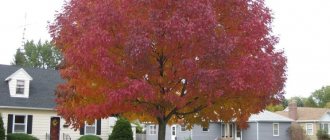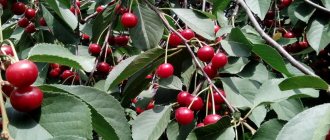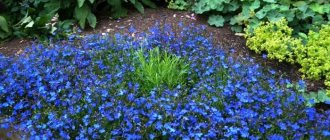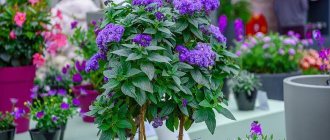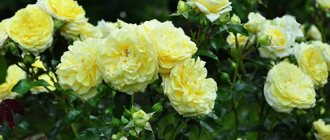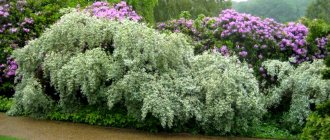- Which maple to plant on the plot
- Preparatory work before planting a tree
- Planting maple and caring for it
Thanks to its extraordinary decorativeness and flexible nature, maple is often used in landscape design in the Moscow region. Planting and caring for maple does not cause any particular difficulties, and the returns from it are very high.
The tree is undemanding to soil and tolerates frost. And if the young shoots freeze in winter, in the spring it will grow new ones. Landscape design studio STROY-LAWN invites you to create a design project for your site, as well as professionally carry out planting and landscaping work. 8 (916) 999-99-20
Elegant foliage attracts attention throughout the warm season. In spring, inflorescences of small bright yellow fragrant flowers stand out clearly against the background of blossoming burgundy leaves. The grown leaves turn green and take on the shape characteristic of each species and variety: five-fingered, carved, pointed. There are variegated forms of maples with variegated foliage. All summer long, bright red, pinkish, yellowish-green clusters of winged fruits stand out against the background of maple greenery. In September, the ripened seeds lose their brightness, but it is then that the leaves begin to change their color. In different species they are scarlet, yellow, orange, pink, burgundy.
And even the trunks of these trees can be decorative. The Tatarian maple has black bark, while the fan maple has greenish, light brown, beige bark. There are several varieties of snakebark maples. Their trunks are covered with an unusual “snake” pattern: alternating white and green or brown vertical stripes.
Planting and caring for a maple tree does not include trimming. This is one of the few trees that independently forms a beautiful, dense, symmetrical crown. If the plant is not used in a green hedge, it does not need to be pruned annually. The trunk grows straight and slender, and the beneficial shade of the dense crown saves the surrounding area from the heat.
Ginnala Maple
Globoza maple on a low trunk
Maple Royal Red
Tips on how to grow maple from seeds at home
Maple is considered one of the most beautiful trees. Poets sang about it, painters wrote about it, and an image of its carved leaf is on the flag of Canada. Amazingly beautiful maple leaves of different colors delight the eyes of passers-by.
red leaf maple
Ripening, collecting and preparing seeds for planting
Different maple species reproduce in different ways. This can be cuttings or grafting, seeds. Maple seeds ripen in August, and they begin to fall to the ground with the onset of autumn. Those who want to grow a maple tree with their own hands need to collect them by finding them among the fallen leaves.
The maple seed looks like a double flat lionfish with a pair of wings. The fruit itself consists of two parts, where each seed is bare and contains a large green embryo.
Today there are about 150 species of maples, most of which are native to North America. Maple feels good both in tropical areas and in northern regions. Maple seeds are planted both in spring and autumn. To plant them in the spring, they are prepared in the fall, creating an artificial winter for them by placing them in the refrigerator in a container with wet sand. Under these conditions, the seeds can be stored for up to two years. With the onset of spring, from April to May, the seed can be planted in the ground. Before planting, it is recommended to soak them in peroxide for two days, so they will germinate faster, in about three weeks.
When planting in autumn, choose a place on the site that is quiet and sunny, dig a hole 70 cm deep and 50 cm wide. A sand-peat mixture mixed with soil from digging is introduced into this hole. The seeds are planted to a depth of four cm and with their wings up.
The seedling grows slowly; at one year of age the tree can reach a height of 80 cm. The seedling requires good watering. A handsome tree grown from a seed will create excellent shade with its chic crown and a place to rest, and the seeds and leaves will help in the treatment of kidney diseases and colic, bronchitis and herpes, etc. Maple has positive energy, and growing it from a seed is a long-term investment for descendants.
Sugar maple
According to biologists, for normal growth, maple seeds for planting must be taken either local or from a similar climate, planted in light loamy soil, watered and protected from the north wind.
What methods are there for growing seeds?
Cold stratification method
Many types of maple are grown from seeds using this method. These include maples:
Seeds that are not spoiled or rotten are selected, and dried ones are pre-soaked.
Thanks to this method, the seeds germinate quickly enough. For the seeds you will need a small plastic bag filled with growing material consisting of sand, peat moss or vermiculite or paper. To prevent fungus, it is advisable to have sterile material. To moisten, add a little water to the sowing mixture. And to prevent mold, you need to add just a little fungicide.
Next, the seeds are packaged in 25 pieces in a bag, which needs to be tediously ironed with the palm of your hand to remove air and closed with a zipper. The bags are placed in the refrigerator, where they are kept at a temperature of 1 to 4 degrees Celsius, which promotes germination. Some species are quite picky and a temperature difference of a couple of degrees will negatively affect the growth of seeds. For example, an American maple seed feels comfortable at +5 degrees, and red maple seeds need +3 degrees.
Most types of seeds are kept in the refrigerator for 3-4 months, but large-leaf maple needs 40 days. Every fourteen days, the bags should be checked for excess or lack of moisture, the presence of mold, etc. When growth begins, the seeds are removed from the refrigerator. Sprouted seeds are planted in moist soil to a depth of 1.5 cm. To ensure that the sprout takes root, the seeds can be planted temporarily in a tray.
Cold and warm stratification method
This method is well suited for mountain and Asian species with a very hard shell that requires treatment in the form of an incision, soaking in peroxide, and warm water. For two months, the seeds are stored at a temperature of 20 to 30 degrees. Next, the seeds are subjected to the above-described cold stratification method.
Growing maple seeds directly in the soil
In some types of maples, for example, silver maples, seed shedding occurs at the beginning of the growing season. These seeds do not hibernate and do not need additional care. You need to plant the seeds almost after collecting them and they will germinate quickly. Planting involves placing the seeds in moist soil mixed with fallen leaves without additional care.
Some seeds may not grow in the first year of planting, but will germinate only the next year. If a small percentage of seeds germinate, there is a chance that they have been spoiled. In this case, it is advisable to plant new ones.
A maple grown from seed can grow up to 30 meters tall.
Having decided on the desired type of maple, we purchase or find and collect the seeds ourselves; now growing maple from seeds at home will not be difficult for you. Fortunately, our country has a large selection of varieties of this fabulous tree.
The grown tree will delight you and then your grandchildren!
Source
Description of Norway maple
But the tree is no less spectacular in the second half of spring, when its branches are covered with corymbose inflorescences of 15–30 fragrant yellow-green flowers. They open up until the maple leaves bloom. On sunny days, the quiet buzzing of bees and other insects attracted by the flowers comes from the crown.
The tree is an excellent honey plant; thanks to the shade formed by the foliage, it can cover an open area from the scorching sun and cold winds.
It is not surprising that the question: “How to transplant a maple from the forest to a plot or grow a seedling yourself?” interests many summer residents.
But before you decide to plant, it is important to know that an adult tree reaches a height of 30 meters and requires significant free space. The superficial root system of the maple, blocking access to nutrients and water, interferes with the growth of surrounding crops.
Amazing facts
- Maples are excellent honey plants, which is why they have won the love of beekeepers, who often plant them on their property.
- The maple leaf is depicted on the Canadian flag and has become a true symbol of this country.
- The sap of some maple trees is used to make sweet syrup.
- In Japan and China, the maple leaf is a symbol of love.
- The tree is often mentioned in songs, stories, and poetry.
- The amulet of a dried maple leaf helps to better understand the beauty of nature and open up more widely to all human feelings.
- In the traditions of the Slavs during weddings, the bride’s tree was viburnum, and the groom’s was maple.
Planting Norway maple
If the summer resident has seedlings with an open root system at his disposal, Norway maple trees are planted in the ground:
Plants with ZCL can be planted throughout the warm period. Since the roots are not damaged, planting and caring for Norway maple will not cause any trouble even for a novice gardener.
For the seedling, choose a well-lit place, at least 2.5–3 meters away from other perennial plants. Trees need fertile soil that is permeable to moisture and air. It is useful to add sand, peat, and rotted organic matter to chernozem or clay soil before planting.
Add to poor soil in equal parts:
To prevent the maple root system from being damaged by stagnation of melt and groundwater, a 15-centimeter drainage layer of expanded clay, broken brick or crushed stone is poured onto the bottom of a wide planting hole.
If the roots of the tree are exposed, they should be placed in water for several hours before planting. The seedling in the container is watered abundantly so as to wet the entire earthen ball.
The prepared plant is placed in a hole next to a pre-fixed support so that the root collar is slightly above the soil level. The planting hole is filled with prepared soil, the soil is compacted and watered. The tree trunk circle is generously mulched with dry soil, peat or other suitable material to prevent drying out of the soil.
When is the best time to transplant maple from the forest to the site? Transplantation from the forest
Most often, young plants are moved from the undergrowth to the dacha plot: juniper, thin mountain ash, rose hips and small conifers. The younger the plant, the easier it will take root in a new place.
For the transplant to be successful, you must follow simple rules.
2. It has been noticed that a tree or shrub takes root more easily when it is transplanted from soil rich in nutrition to soil that is less fertile. And the situation is much worse for a seedling when transplanted from soil poor in nutrients to rich in nutrition. Based on this observation, grab a couple of buckets of soil from the forest, mix it with the soil obtained when preparing the planting hole for the new plant, and do not add any fertilizers.
Margarita Turkina
The purposes of planting trees can be different - creating natural shade on a site, a hedge, wind and noise protection, creating a background for planting ornamental plant species, and so on. Trees common in natural areas, with rare exceptions, are not available in nurseries. Therefore, it is best to transplant the selected plants from their natural habitats.
Caring for Norway Maple
According to the description, Norway maple is an unpretentious frost-resistant tree that does not require labor-intensive and continuous care.
And yet plants, especially young ones, need care. In spring and autumn, if the weather is dry, trees are watered once a month. On hot summer days, when the broadleaf crop evaporates a lot of moisture and suffers from its loss, watering is carried out at least once a week, at the rate of 2 buckets per tree.
In addition, the tree trunk circle under the tree is loosened and cleared of weeds. From the second year of life, the plants are fed twice, adding humus or long-acting complex fertilizers to the loosened soil.
Norway maple does not need special formative pruning. If in the spring some of the branches are damaged, or there are broken branches, they are cut down to living wood, and the stumps are treated with garden varnish.
How does maple spread?
In nature, Norway maple easily reproduces by seeds and root shoots.
Young plants appear in abundance around the stumps of old maples. Wind-dispersed seeds germinate, becoming dense undergrowth. If desired, it is not at all difficult to propagate the plant yourself. To harden the seeds, they are planted in the ground in the fall. Seedlings with several leaves dive in spring. Further care before planting the Norway maple in a permanent place consists of regular watering, weed control and protecting the seedlings from the cold.
You can bring a seedling from the forest. In this case it is important:
With the advent of original ornamental varieties, gardeners became interested in how maples with variegated and anthacian foliage color spread? Such plants reproduce vegetatively using air or root layering.
How to care for cuttings
Caring for developing cuttings consists of shading from the hot sun, regular watering, weeding, and loosening the soil; for the winter, young plants are hilled up and mulched (the roses are additionally covered with leaves on top with a layer of 10-15 cm). When the temperature is set at 0+2 degrees, a reliable frame is placed over the rooted conifers and roses and covered with film; when the temperature further drops to minus 3-5 degrees, leaves or sawdust are poured onto the film in a layer of 5-7 cm and another layer of film is placed on top. In the spring, as the snow melts, the cover is gradually removed and covering material is pulled onto the frame over the plants to protect against sunburn. Well-rooted cuttings of winter-hardy conifers and deciduous plants can overwinter without additional shelter - under natural snow cover.
Pests and diseases of Norway maple
Trees planted on the site are exposed to pest attacks and the risk of various diseases.
The enemies of maple are whiteflies, mealybugs and some types of leaf rollers. To defeat insects, insecticide treatments are used throughout the growing season. Be sure to collect and destroy fallen leaves in autumn. Pathogenic fungi pose a great danger. They call:
Manifestations of Norway maple disease, as in the photo, are foreign spots on the leaves, deformation and wilting of shoots, and “witch’s brooms.” Sometimes the color of the wood changes, the leaves dry out for no apparent reason.
The affected parts of the plants are cut out, the foliage is collected and destroyed. Maple is treated with fungicides in 2-3 doses. The exception is wilt. Infected trees are dug up by the roots and burned, since pathogens remaining in the soil affect not only maples, but also potatoes, sunflowers, beets, and other crops.
Source
Planting red maple in open ground
American maples are one of the few representatives of the genus that grow well in shade and can withstand prolonged flooding of the root system. Maples love rich nutrient substrates and cannot tolerate sand and rocky soils. The bright red decorative color of the foliage does not appear on alkaline soil. Maple is planted in an area with fertile soil.
The tree requires constant moisture, so good drainage is made at the bottom of the hole so that excess water drains away. Complex mineral fertilizer is applied to the planting hole, mixing it with the soil. The size of the hole must correspond to the root system. The seedling is watered and the tree trunk is mulched with peat, compost, sawdust or straw.
We grow maple bonsai at home: choose blue, blue or red tree color
Bonsai (translated from Japanese as “grown in a tray”) is a smaller copy of a tree grown at home or in a country house. The effect is achieved by regulating the size and shape of the plant's root system. It is not easy to grow a maple bonsai with your own hands; the process requires patience and time. But the end result fully lives up to expectations: a deciduous tree behaves like a full-fledged fellow tree; in the process of blossoming and withering, the leaf changes color and then falls off. The compact size of the dwarf plant allows it to be kept even in an apartment; taller individuals decorate verandas and garden plots.
Agricultural cultivation technology and care
Red maple is frost-resistant and undemanding to soil moisture. In its homeland, North America, it is considered one of the most drought-resistant maples. At the same time, this is one of the few species that grows on flooded, almost swampy soils.
The tree is unpretentious in care and requires much less attention than fruit trees. In the summer, red maple trees enjoy sprinkling of leaves during dry weather. In the spring, two weeks before the buds open, sanitary pruning is carried out, complex mineral fertilizer is applied and the tree trunk circle is mulched.
When pests appear, treat the tree with insecticides. It is most often affected by maple whitefly, mealybug and leaf weevil. Coral spotting is a common maple disease - burgundy spots appear on the bark.
The affected branches are removed and burned, the cut areas are smeared with garden varnish. In autumn, maple leaves are collected from under the trees to prevent the spread of infections.
Where does the maple tree grow?
This colorful tree primarily grows in the northern hemisphere: Europe, Asia, North America. The tree's main habitat is temperate latitudes. Only a few species have settled in the tropics; in the Southern Hemisphere, the only one is the Laurel Maple.
In Russia you can find about 20 specimens of the plant.
- In the European part of the country, the following are common: white maple, Norway maple, and Tatarian maple.
- In the Far East, the diversity is much brighter; here you can find: small-leaved maple, Japanese maple, yellow maple, bearded maple, river maple, ash-leaved maple.
- In the Caucasus, other species predominate: alpine, three-lobed.
Pruning and crown formation
As a rule, maples naturally have beautiful spreading, conical, pyramidal or rounded crowns that do not require formative pruning. In spring and autumn, when the movement of sap is slow, sanitary pruning of branches is carried out, removing dried and frozen shoots affected by pests or diseases.
Excess root growth and shoots of competitors that thicken the crown and intersect with each other are also cut out. With age (about 10 years after planting), the skeletal branches of the tree can be shortened by 2/3. If the height of the tree needs to be kept at a certain level, the top is trimmed annually.
Construction portal No. 1
When someone thinks about what to plant on their plot, fruits and berries immediately come to mind. But you can also use trees for landscaping that do not produce edible fruits. They simply delight with their beauty. You immediately remember an autumn park somewhere in New York. Can you guess what plant we are talking about? Canadian maple is a tree with a large lush crown. Otherwise it is also called sugar maple. This is where the famous maple syrup is extracted. Red maple is a wonderful plant for planting in city parks and squares. It is quite unpretentious in care, resistant to frost, and practically does not get sick if it is grown correctly. See below for a description of the tree itself.
Wintering red maple
Red maple is a winter-hardy ornamental plant. It does not require special shelter for the winter. Only young seedlings can freeze in harsh snowless winters.
To cover a small tree, a frame is built, which is wrapped around with non-woven covering material. To prevent the roots from freezing, pour a thick layer of mulch into the tree trunk circle.
To successfully winter maple trees, stop feeding them with nitrogen-containing fertilizers in mid-summer. To prepare for frost, the tree only needs potassium and phosphorus. In the fall, before the soil freezes, you can carry out moisture-recharging irrigation, which will protect the root system from damage.
Digging the selected plant
Once a tree has been selected for transplantation (taking into account the minimal effort required to transport it to a permanent place of growth), you need to dig up the root system of the plant. It is best to take the diameter of the root ball being formed in the region of sixty centimeters. Using a bayonet shovel, we cut the turf along the marked path until it stops. Now, standing sideways to the tree near the outer border of the designated circle, we begin to dig a ditch one shovel wide.
Having completed this stage, we continue to select soil from the intended ditch at a new depth. The goal is to form a root ball of earth in the form of a cone with a height of forty to fifty centimeters. The end result of this work should be what you see in the picture below.
Due to its cone-shaped root ball, the tree can easily be toppled on its side by tipping it into a wheelbarrow, stretcher or some other material for carrying the plant.
If the soil is crumbly, it is better to wrap the roots several times and tie them with a cloth made of natural material. This will save the lump from destruction and, accordingly, preserve the roots. In this case, you can plant without removing the fabric, as it will decompose naturally in the ground.
Application in landscape design
The culture is used for single and group plantings in garden plots and parks. Small decorative forms are grown as pot plants and created as bonsai.
Maple with red leaves is suitable for decorating the banks of reservoirs and recreation areas, and creating hedges. It combines beautifully with elms, oaks, birches and lindens. And also with coniferous trees - pines, spruces, fir, larches. In rocky gardens, low varieties of trees look good next to bergenia.
Like burning candles, maples decorate gardens and parks with red autumn foliage. Unusual trees stand out against the yellow-orange autumn background. Bright colors create a festive, good mood, which is so lacking on rainy autumn days.
Varieties with photos, names
There are a huge number of varieties and decorative forms. As a rule, gardeners are engaged in growing spherical shapes. It does not grow so rapidly, but it can decorate any garden plot. There is also a palmate form with dark green leaf blades divided to the base. The highlight of the Drummond maple is that the leaf blades turn pink when they bloom. They are then covered with an elegant white border. Another form of Golden Globe is distinguished by a spherical crown and magnificent golden leaves.
Popular varieties include:
- The globosum is spherical in shape and up to 7 meters high.
Globosum - Crimson King is up to 20 meters high with leaves of an unusual purple color.
- Crimson Sentry is an unusually slender tree with a crown diameter of up to eight meters and branches directed upward.
Crimson Sentry - Deborah with fairly wide leaves - up to 20 cm.
- Emerald Queen - grows very quickly, has palmate-lobed leaves.
Emerald Queen - Royal Red, the leaves of which are colored red-bloody.
Features of Norway maple
Norway maple has a height of about 30 meters, sometimes it can be higher. The surface of the trunk is covered with fissured bark of gray-brownish, almost black color. The bark on young branches is gray-red and relatively smooth. The crown shape is round.
The branches are powerful and wide, they are directed downwards. Simple palm-shaped leaf plates are oppositely located, coarsely toothed blades (sometimes from 5 to 7 pieces) are pointed at the ends. The front side of the foliage is dark green, and the back side is light green.
In autumn, the leaf blades acquire an orange or yellow color. If you break the petioles or veins of the leaves, milky juice will appear at the site of the damage. Flowering is observed in the first half of May. The corymbose inflorescences consist of 15–30 fragrant flowers, colored greenish-yellow.
Such a tree is a dioecious plant, so it can have either male or female flowers. Pollination occurs thanks to insects. The nectary has the form of a flat ring, the bases of the stamens are immersed in it.
It is placed between the petals and the ovary. The fruit is a lionfish, which splits into 2 single-seeded fruits. The fruits ripen in the last days of summer, and they can remain on the branches until the end of the winter. Norway maple is a good honey plant.
This tree is similar in appearance to another species, namely sugar maple or Canadian maple. These plants can be easily distinguished by the color of the juice that is released from the petioles; for example, in sugar maple it is transparent.
Also, the Norway maple does not have such a rough and rough bark as the sugar maple, and in the autumn its leaf blades become less brightly colored. In Norway maple, the shape of the leaf blades is more spread-out. The buds of the Norway maple are light red, while the buds of the sugar maple are rich green.
What does a maple leaf look like?
Norway maple leaves are large, up to 18 cm in diameter, have clear, pronounced veins, have 5 lobes, and end in pointed lobes. ... The leaves are dark green above, light green below, and are supported by long petioles. In autumn they acquire red, brown, brown, burgundy shades.
Interesting materials:
How to use Nordic walking poles? How to use Vanish Gold for carpets? How to use carpet cleaner if you don’t have a vacuum cleaner? How to change the background for a presentation? How to change the language in the VKontakte application for Android? How to change the OKVED code for individual entrepreneurs? How to change your email password If you forgot? How to change your digital signature password if you forgot? How to change your Instagram password if you forgot the current one on your iPhone? How to change the keyboard shortcut to change the language?
Planting Norway maple
It is recommended to plant Norway maple in open ground at the very beginning of spring or autumn. When choosing a place for planting, you should take into account that the distance from the seedling to any other plant should be at least 2.5–3 meters.
If maples are used to create a hedge, then a distance of 2 meters should be maintained between them. For planting, choose a well-lit area or one that is in light partial shade. The soil should be well drained. When digging a hole, you should take into account that its depth should be identical to the height of the root ball.
In this case, the width of the hole must be made 4 times larger than the root ball. If the groundwater in the area lies too close to the soil surface, then the depth of the hole should be increased, since at its bottom it will be necessary to make a drainage layer, the thickness of which should be at least 15 centimeters. To create this layer, you can use crushed stone, broken brick or screenings.
Under no circumstances should the seedling's root system dry out before planting. Therefore, it is recommended to immerse it in a container of water for several hours.
To fill the planting hole, you should use a nutrient mixture consisting of humus (peat compost), sand and turf soil (3:1:2). First, you need to pour from 120 to 150 grams of Nitroammofoska into the hole, only then the root ball of the seedling is placed in it.
When the roots are neatly straightened, the hole needs to be filled with a nutrient mixture. After planting, the root collar of the plant should rise several centimeters above the surface of the site. The planted maple must be watered using 30 liters of water.
After the liquid is completely absorbed, the root collar of the seedling should drop to the level of the surface of the area. Do not forget, in the first days after planting, mulch the tree trunk using dry soil or peat; the layer thickness should be within 3–5 centimeters.
Planting and propagation
You can propagate Canadian maple so that the tree grows strong and healthy in different ways: seeds, seedlings, layering. Each method is good in its own way. Choose areas that are well lit by the sun - then the crown will be denser. In places with insufficient sunlight, the leaves become small and the saturation is lost.
The propagation of Norway maple by various methods will be discussed below:
- Seeds. Simply collecting lionfish and planting it in the ground is not enough. Seeds must be stratified. To improve germination, in the fall they are placed in sand or peat and kept in the sand at a temperature of no more than 3 degrees. There is no need to remove the seeds from the wings. Sowed in April. The soil should be moist and fertilized, the optimal depth is 4-5 centimeters. The appearance of sprouts should be expected in two weeks. By the way, they grow quite quickly - up to 60 cm annually. In just 7 years, a two-meter tree will tower over your site. Up to 25 years, this type of maple grows in width and height, then it only increases in width. Development slows down or stops completely after age 50.
Maple on the site - Saplings. If you have maple seedlings, they can be planted both in the fall (wait for the leaves to fall) and in the spring. It is advisable to do this in March-April, when the buds have not yet bloomed. Particular attention is paid to the integrity of the root system. When purchasing, select seedlings with a large lump. The depth of the hole is at least 50 cm; humus is placed at the bottom. When planting without a clod, carefully straighten the roots to avoid creases, carefully compact them and water them.
- Layerings. Another common method used by both beginners and experienced gardeners. Propagation by cuttings begins with the fact that in the fall you cut woody branches 25 cm long from the tree. Then you bury them in the sand and store them in the basement so that the soil does not freeze. In spring, plant in prepared soil. By the way, you don’t have to wait for autumn, but cut the cuttings in the spring, treat them with growth stimulants, and plant them in the ground, covering them with a plastic bottle.
It is important! When planting maple, the distance between trees should be 2-4 meters. Otherwise, large adult animals will interfere with each other.
Norway maple care
Newly planted Norway maple trees need frequent watering. Even after the plant gets stronger and grows, it will need systematic watering, especially in the summer months. In spring and autumn, watering the tree is carried out once every 4 weeks, and in the summer this procedure is carried out once every 7 days.
When watering, a young plant should need 40 liters of water, but if the tree is mature, then 20 liters will be enough. But it should be taken into account that if the color of the foliage of the tree has become pale green, this indicates that the soil is very waterlogged.
If a plant feels a lack of water, its leaf blades droop. After watering, it is necessary to systematically loosen the surface of the tree trunk circle, while simultaneously pulling out weeds.
If all the necessary fertilizers have been added to the planting hole, then there is no need to feed the plants until the end of the current season. After spring comes, the maple will need to be fed; to do this, the surface of the tree trunk needs to be covered with a three-centimeter layer of rotted manure.
You can also use special tablets with slow release of nutrients for feeding. They should be spread out in the root zone. From the beginning of the growing season until the end of spring, such feeding should be done once every 2 weeks, in the summer it is carried out once every 4 weeks, in the fall there is no need to feed the maple.
The tree's dormant period begins with the first frost and continues until March. If the maple is still young, then it will need good shelter for the winter. Its standard must be wrapped in burlap, which is secured with a rope. This will protect the plant from severe frosts and from rodents.
The root collar of the plant must be covered with spruce branches. As the plant matures, its resistance to frost increases, and soon it will not be necessary to cover it for the winter.
Trimming
Maple only needs sanitary pruning, during which all branches and stems that are frozen, injured, dried out, or damaged by diseases and pests should be cut off. You also need to cut out all the root growth.
If desired, you can shorten those stems that stick out in different directions, and also remove shoots growing inside the crown. There is no need to perform formative pruning, since the natural spherical shape of the maple is very attractive without it.
Diseases and pests
If the tree's branches begin to die, and small burgundy spots appear on the surface of the bark, this indicates that it is infected with coral spot.
Those branches that are affected must be trimmed and destroyed, and the cut areas should be coated with garden varnish. Garden tools should be disinfected both before and after pruning.
Pests that can inhabit maple trees include whiteflies, mealybugs and leaf weevils. Branches affected by whitefly larvae must be pruned and destroyed, and then the plant is treated with Ammophos.
For preventive purposes against mealybugs, maple leaves are treated with Nitrafen until the buds swell. To get rid of weevils, you need to treat the tree leaf by leaf with Chlorophos solution, which is prepared strictly according to the instructions.
